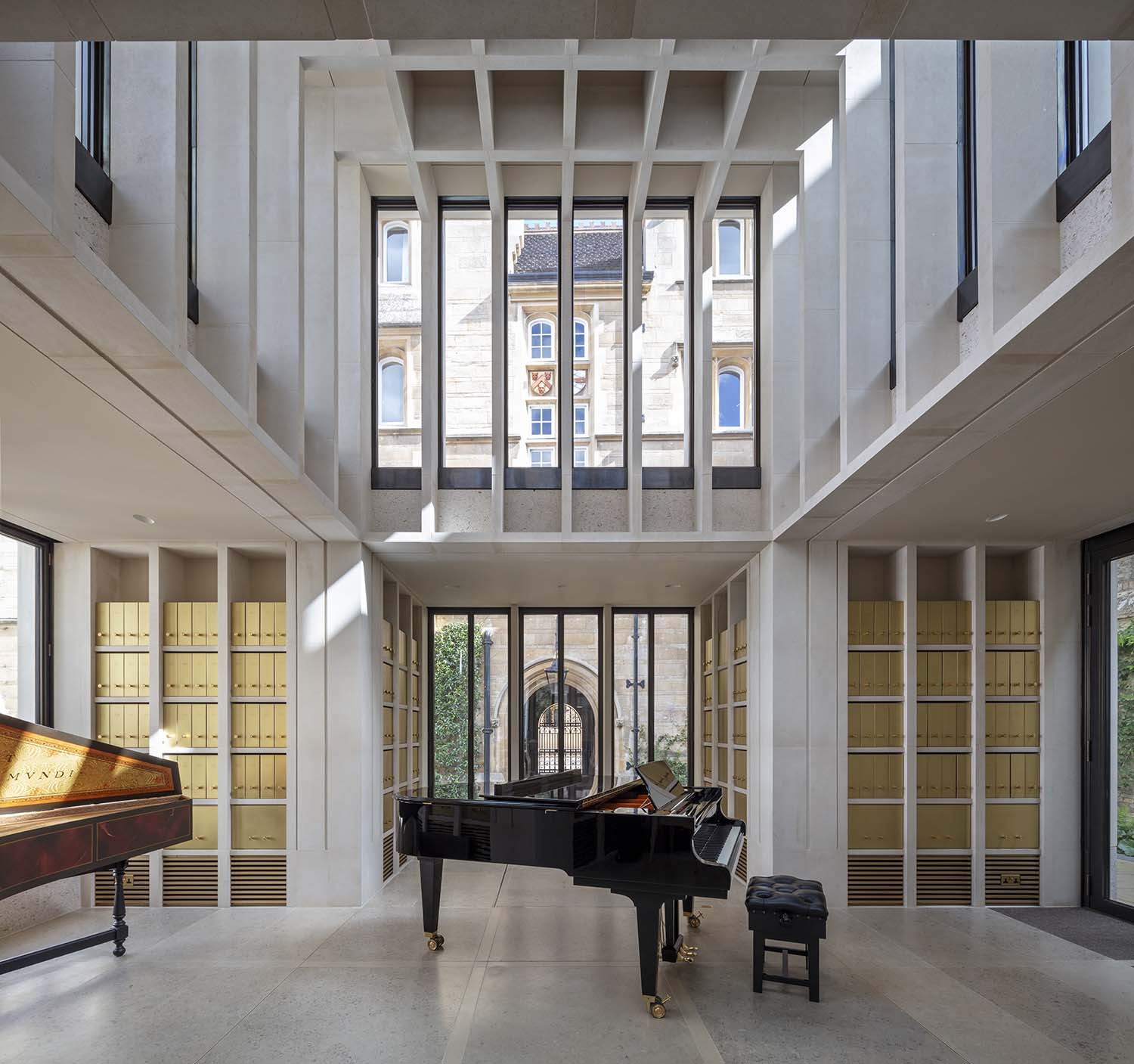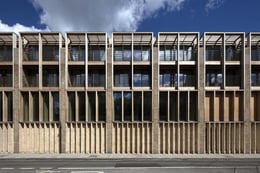Login
Registered users
The storied urban fabric of two ancient English universities now features buildings that express the spirit of our time, like the WongAvery Music Gallery in Cambridge

Níall McLaughlin grew up in Ireland and opened his architectural office in London in 1990. His practice has grown steadily and has won acclaim for a diversity of cultural, institutional and public buildings. McLaughlin might be described as a romantic modernist whose fertile invention is deeply rooted in architectural history. That makes him an ideal choice for the delicate and controversial task of weaving new buildings into the storied urban fabric of Oxford and Cambridge Universities. Every corner of these two foundations, formally established 800 years ago, is protected; every change is contested.
When McLaughlin won a competition to design a new library for Magdalene College, the Cambridge conservation officer told him: “it is not that I like or dislike your design ‒ I do not think you should put any building on that site”. The architect won over the skeptics and the library won the 2022 Stirling Prize for the best British building of the year.

The colleges compete for fee-paying students and they have discovered that housing students on or close to the parent campus produces better academic scores. Planning controls have been loosened to allow them to do that. The traditional pattern of isolated student rooms, dining in hall and studying in a hushed library is being challenged by the preference some students have to work from their laptops in noisy cafés and a craving for social intercourse among foreign students and those who feel disoriented in a world so dominated by tradition. The demographics are changing as the traditional upper-class intake from English boarding schools gives way to upwardly mobile students from state day schools, often the children of immigrants. New disciplines and specialties require dedicated spaces. And colleges are receiving more charitable donations from wealthy alumni for whom prestigious buildings are named.
These factors have generated a steady stream of additions and McLaughlin has been involved in 12 of them as architect and/or master planner. In each, his team respected the context while creating buildings that express the spirit of our time.
As he explains: “A lot of our work has pushed back against the response of most planning officers (and some architects) to prefer a structure that is leaning against a wall and pretending to be invisible. We are very attentive to the characteristics of what is there while inserting a building that asserts itself appropriately and takes its place alongside buildings of previous generations. You are living with your ancestors. Over time we have demonstrated we can do that and have built a relationship of trust with Historic England (the government’s watchdog) and local conservation authorities”.

The challenge is greater in the residential areas surrounding the historic core of both cities. North Oxford is a minefield. Professors and other well-educated owners of Victorian villas ‒ a typology that was despised a couple of generations ago ‒ are fiercely protective and do battle whenever a college dares to propose repetitive student housing in their sacred preserve. In response, McLaughlin has developed a new language that abstracts traditional forms, employing simplified brick gables alternating with ventilation or lift shafts that take the place of chimneys in earlier buildings. Such an approach can easily lapse into pastiche, a timid mimicry of the old, but McLaughlin’s designs have the rigor of Edwin Lutyens (who reanimated traditional forms a century ago) and Louis Kahn, who was similarly inspired.

In his master plan for Jesus College, Cambridge, McLaughlin reworked an existing building, retaining the brick cross walls to give the street façade of the housing a lively rhythm, and he hopes to transform a multi-/story parking garage into a dramatic auditorium. The spirit of Lutyens hovers over a housing complex for University College in Oxford, where he treated kitchens and staircases as projecting bays to avert monotony. In his plan for Master’s Field, an innovative housing complex for Balliol College, the architect employs a favorite strategy that gives depth to the façades. Windows are set back between piers so that the glass is invisible from an oblique perspective. He speculates that the popular dislike of modern architecture has much to do with its shallow façades. As in historic buildings, the deep reveals enliven the exterior and diffuse the light within.

The Balliol plan is remarkable, too, for the configuration of rooms within separate blocks that have a lot of corner windows to light rooms from two directions. Within, each group of rooms shares a common space, three groups share a kitchen, and they can all use a meeting room as a socializing device. For the design of a sports pavilion that serves this complex, McLaughlin has reached back to a Chinese carpentry pattern book, published in the 12th century, just as Oxford was being founded on the opposite side of the world. The guide offers standardized designs for bracketed wood roof vaults in a hierarchy that extends from humble to grand and expresses the social position of the owner. The architect has adapted these principles in a layered timber ceiling of marvelous complexity. It makes an ideal backdrop for yoga sessions. More ingenuity is employed in the Catherine Hughes Building. Founded as one of the first women’s colleges, Somerville lacks the endowments of older foundations, but McLaughlin employed richly detailed brickwork to give a strong identity to the tightly budgeted housing.

Two of his most recent projects in Cambridge were prestige commissions. The Magdalene Library abstracts the college’s 17th-century Jacobean buildings. Gables enclose lofty interiors and by extending them on both axes the rooms can be lit from clerestories on four sides without allowing too much sun to reach the bookshelves. Hoods shade the UV coated glass, and ventilation shafts allow the occupants to control the natural heating and cooling. Acoustical baffles soak up sound within the multi-level volumes. Despite the drift away to casual patterns of study, the library has been in great demand and is open 24/7. Post-Covid it is a symbol of communal activity.

The jewel in McLaughlin’s crown is the WongAvery Music Gallery, a new facility for the music department at Trinity Hall. The brief was exacting: it had to function well as a performance space for chamber music recitals, in which the sound would resonate as well as a rehearsal room for the choir, storage for instruments and a large collection of scores, while opening up to the courtyard through bay windows to serve as a bandstand for summer concerts. It had to be protected from direct sun and climate controlled for a resident harpsichord that goes out of tune with every shift of temperature and humidity.
In the competition McLaughlin was the only architect to make a bold proposal for this sensitive site. “Formal reticence has become part of conservation strategy over the past 50 years”, he explains. “We said, ‘no;’ what is required is something like Bramante’s Tempietto in Rome ‒ a singular building in the middle of a courtyard that holds its own and energizes the space”. His team explored variations on every building form they could think of to achieve the right balance between the new pavilion and the diversity of historic buildings that surround it. They created a stone clad Greek cross, each wing of which opens up, with precast concrete members framing a lantern. It is sited in the half of the court that is almost always in the shade, freeing the sunny half for outdoor gatherings. For performers and students of music WongAvery is a dream come true.
>>> The Magdalene College Library received the RIBA Stirling Prize 2022

































Project: WongAvery Music Gallery
Location: Cambridge, UK
Completion: 2021
Gross internal area: 73 m2
Client: Trinity Hall
Architect: Níall McLaughlin Architects
Main Contractor: Barnes Construction
Consultants
Structures: Smith & Wallwork
M&E: Max Fordham
Acoustics: Gillieron Scott Acoustic Design
Landscape: Kim Wilkie
Stone Consultant: Harrison Goldman
Photography by Nick Kane/David Valinsky, courtesy of Níall McLaughlin